Articles on Animation &Commentary 20 Dec 2007 08:36 am
Persepolis – Opening Soon
- I saw Persepolis for the second time last Thursday. I am an ardent supporter of this film, and any criticism I offer must be taken with that grain of salt. The film is not the most daring of animated films, but it certainly does advance the intelligence of the animated feature – in enormous strides – given the current state of things. However, it is also cinematically annoying.
To start with, I must say the music does no service to this film. A synthesized tinkle and a simplemided tune does not help the emotional state of the film. In my opinion, it detracts rather than adds to the whole. On the second viewing, the music actually became an irritant for me.
The animation is simple, but I often wished it were more rooted in the soul of the characters. Instead, it seems more rooted in the style of the comic. The film is adapted from Marjan Satrapi’s “graphic novel” – “bandes dessinées”. As such the story is simple and built around clever graphics. These graphics served to set the scene for the film, and they play out as short set piece after short set piece with graphic transitions from one to the other. Irises, wipes, morphs all cleverly pull us from one short sequence to the other always 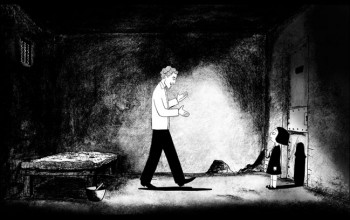 hiding the fact that we’re not living the film; we’re being told what’s happening. In fact, it gets a bit tiring. Something that would work enormously well in a short, gets exhausting and then tedious in a feature.
hiding the fact that we’re not living the film; we’re being told what’s happening. In fact, it gets a bit tiring. Something that would work enormously well in a short, gets exhausting and then tedious in a feature.
This, I think, is the product of inexperienced film makers and the very faithful transition from book to screen. Mind you, as I stated earlier, this is my favorite animated feature this year; I only wish I could feel like I’d want to watch it again. Unfortunately, it feels as though I’ve seen the film, and there’s not much more I can get from it.
I’ve read many of the reviews; some of the more mainstream reviewers are beginning to check in. Deservedly most of those reviews that have been printed have been positive. However, the one by Anthony Lane in The New Yorker feels particularly true for me. In his final paragraph, Lane writes:
- The film is largely in black-and-white, yet the result, far from seeming gloomy, has the pertness and the simplicity of a cutout. I found it, if anything, too simple. The faces are no more than tapered ovals, which makes some of the characters hard to distinguish, and I was left with the nagging, if ungallant, impression that I had been flipping through a wipe-clean board book entitled “Miffy and Friends Play with Islamic Fundamentalism.†There is no denying the boldness of “Persepolis,†both in design and in moral complaint, but there must surely be moments, in Marjane’s life as in ours, that cry out for cross-hatching and the grown-up grayness of doubt.
I’ve seen a number of interviews with Marjane Satrapi and co-director Vincent Paronnaud. They’re starting to repeat themselves. At my initial screening, I was given a press book. Therein were a number of official interviews with the staff and cast. I’d like to post one with “Art Designer,” Marc Jousset. It’s informative, not too long and it gives another voice to this fine feature.
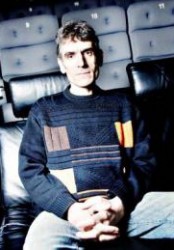 Interview with Marc Jousset – Art Designer
Interview with Marc Jousset – Art Designer
Why did you decide to produce Persepolis almost completely in a “traditional” way, not using computer generated images?
The question of which technique to use, arose very quickly when we discussed the movie. We started with 2D images on pen tablets, but we were not totally happy with the result. The lines lacked definition. It also seemed logical that Marjane should be able to work with the animators using the tools of her trade; paper and ink. It was clear that a traditional animation technique was perfectly suited to Marjane’s and Vincent’s idea of the film.
It’s an animation film with many characters…
Development took a long time, because of the sheer number of characters. For Marjane’s character, there were five separate steps: little girl, pre-teen, teenager, young woman and adult. Since it was also based on real events, and took place in Tehran under the Shah’s regime, then under Khomeini’s revolution, (not to mention Austria), we had to take into account the way people were dressed. There are scenes taking place at the university, in airports, at a punk concert, so it was impossible to draw only two or three characters. We had to animate a good deal of extras. However, we were lucky. Marjane drew all the characters. I thought we would have 200 model sheets to do, each character seen through different angles, so there was no discrepancy from one shot to the other, but actually we made over 600! I think it’s a record for an animated movie.
Did the use of black and white make things particularly difficult for an animated movie?
Using only black and white in an animation movie requires a great deal of discipline. From a technical point of view, you can’t make any mistakes. As soon as an eye isn’t in the right place, or a pupil not perfectly drawn, it shows up straight away on the large screen. It’s even more obvious in this particular film since it’s not a cartoon with codes, conventions and distortions. We were closer to Japanese animation because of the story’s realism, but we couldn’t apply the techniques used in manga. As a result, we had to develop a specific style, both realistic and mature. No bluffing, no tricks, nothing overcooked. With animation director Christian Desmares, twenty animators worked on the movie. Marjane had quite an unusual way of working. Each sequence (1,200 shots) was given to an animator. Marjane insisted on being filmed playing out all the scenes. Given that she’s a genuinely talented actress, it was a great source of information for
the animators, giving them an accurate approach to how they should work. It was also very encouraging for them that she was so committed and passionate. Usually, in animated movies, directors are rarely so concerned with the day-to-day work on the film. After animators, the assistant animators put the finishing touches to the drawings and check them against the original. Marjane’s drawings look very simple and graphic, but they’re very difficult to work on because there are so few identifying marks. Realistic drawings require outstanding accuracy.
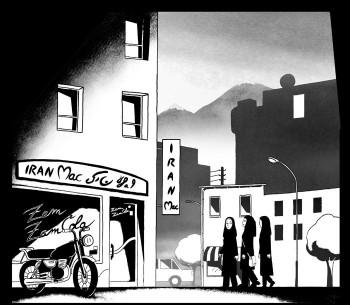 How many drawings were needed for Persepolis?
How many drawings were needed for Persepolis?
About 80,000 drawings for around 130,000 images. That’s quite reasonable for a feature made in the traditional way.
What do you think are Marjane Satrapi’s best attributes?
It’s a combination of rigor and generosity. She was always there for you, and never acted like a diva, like filmmakers who pop in once a week to hand out praises and criticisms. Not thinking about what memories this process might rekindle in her, she was totally committed and involved. She even animated certain scenes in the movie. It brought a unique atmosphere to the team and the collaborative effort.
What about Vincent Paronnaud?
His rigor, his eye and his daring. Marjane and Vincent have always favored content, whilst being very respectful to the visual work done. The story always came first. It’s not a movie made by technicians. They went to work on PersepoHs as though it were a live-action film.
Vincent is very good at artistic direction, composition, playing with black and white, and Marjane masters that as well. She was, however, more focused on the accuracy of emotions and feelings. Each had enough hindsight with his or her work, so that their advice stimulated the other. It’s quite amazing to see them work together. They are a true two-some.
What was the main challenge for you?
To be on schedule, and to stay within budget, whilst maintaining our requirement for high quality. The budget was 6 million Euros, which is reasonable for a 2D movie made in France. I’ve rarely seen a team so focused on a project, not only for the technical challenge, but also for the story itself. I think the culmination of the fact that it was a true story, that the main character worked with you, that an animated movie dealt with a current issue and that it was intended for adults was tremendously exciting for the team.
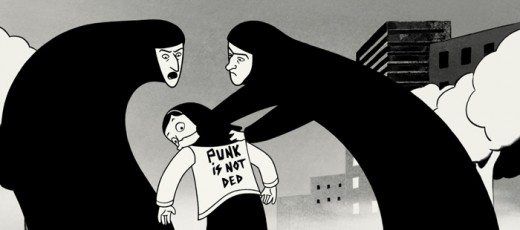
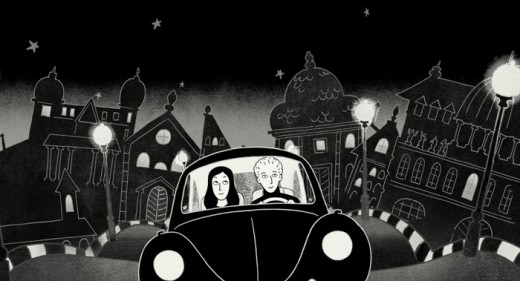

on 20 Dec 2007 at 3:53 pm 1.Tim Rauch said …
I just saw Persepolis for the first time the other night and really enjoyed it. This film has the possibility of making a wider range of topics in animated features accepted by the big studios and the public. Can you imagine if someone had done an interpretation of “Maus” that was as effective as this? Would’ve been a great movie. Or any of Will Eisner’s books. Or something by Steinbeck, or Hemingway, or Arthur Miller. There have been these kinds of animated films for years, but seeing more of them get big money and big distribution would be great. Persepolis will hopefully be seen by more people and really communicate some important messages about war, politics, and humanity… which is obviously an impressive list! Marjane Satrapi really deserves a lot of recognition for putting this remarkable story together.
on 01 Jan 2008 at 2:38 am 2.chris webb said …
Saw Persepolis today. I’m very happy to see that it got so many good reviews. It’s good for animation.
But I was disapointed. Michael, you are right — the film is told to us, not shown to us. We see very few scenes dramatized. In other words, the characters get to do very little acting. They talk and talk… but I wanted to see them acting these conflicts out. (I mean, that’s why we go to the theater, to see conflicts acted out.)
In The Incredibles there’s a scene where Bob Parr comes home after having been in a burning building. His wife Helen confronts him and they argue. And they don’t just talk – there’s blocking and a climax to their argument. And they don’t necessarily resolve their problems. That’s an example of what I mean by “acting conflicts out.”
The story of Persepolis allows for dozens of opportunities like this, but they chose to tell their story in a different, and in my opinion, a less effective way.
Still, I’m glad I saw it, and hope Ms. Satrapi nd her crew make more films. Hers is a voice we need.